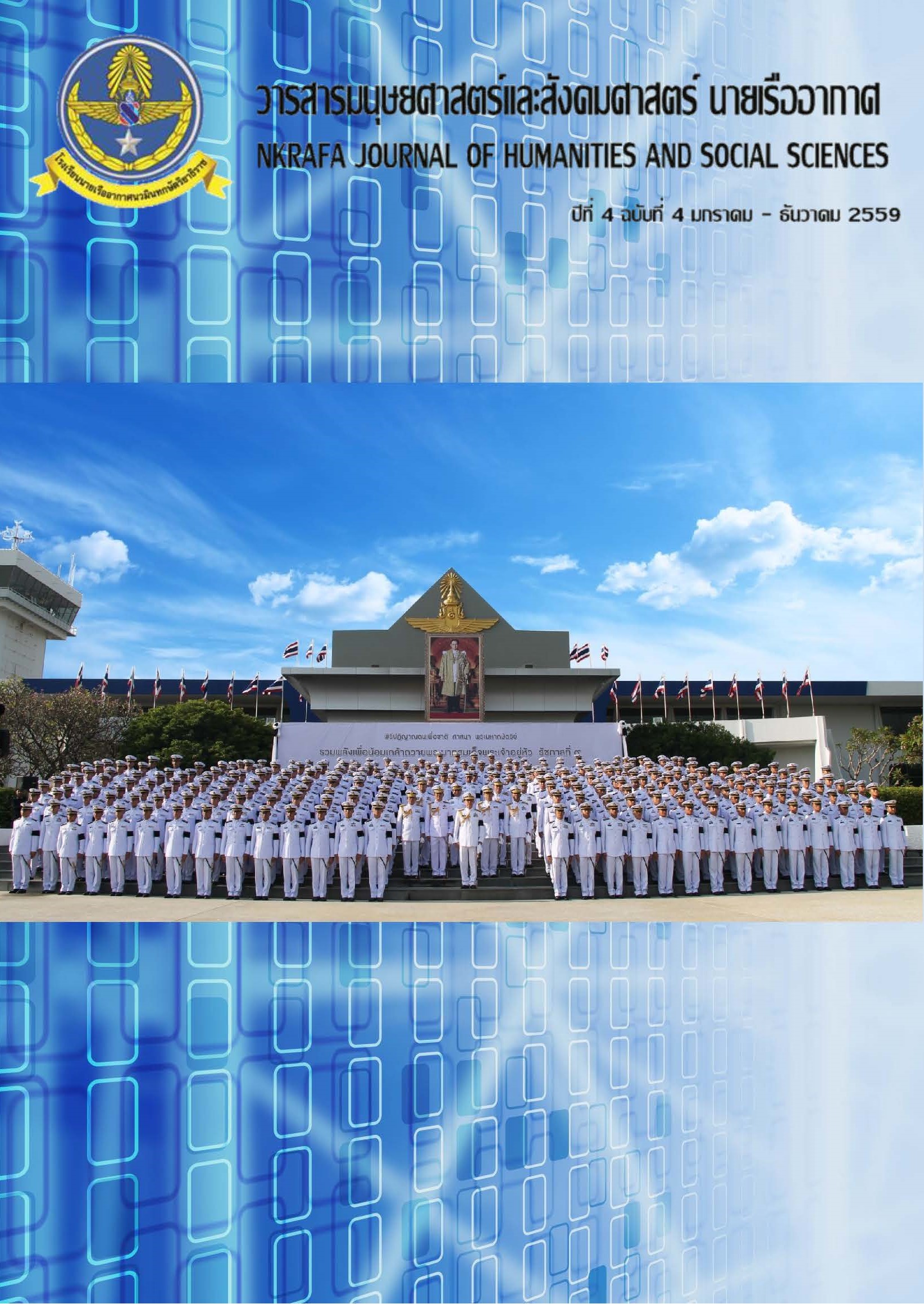Service Blueprint: Service Encounter Flowcharts in Managing Service Quality for Hospitality Business
Main Article Content
Abstract
The hospitality business is identified as one of many businesses focusing on service quality be-cause of its specific characteristics. Providing an excellent service towards customers and having service quality required knowledge and arts to deliver the effective service. Therefore, the study and understanding of service encounter features between the service providers and the customers are recognized as the essential context to service performance. As well, these lead to the success-ful service delivery and generate the customer satisfaction. This academic article is aimed at pro-posing the concept of service encounter. Then, the service blueprint which is vital tool to service delivery design, brings about the service delivery process to be effective. Examples of service en-counter in hospitality business, based on the front/back stage and output/service cost are also proposed. The consequence of this article indicates that the service blueprint is considered as the excellent tool in managing service quality since the exploration of bottleneck points in service pro-cess and service quality improvement can be discovered herein.
Article Details
บทความที่ได้รับการตีพิมพ์เป็นลิขสิทธิ์ของวารสารมนุษยศาสตร์และสังคมศาสตร์ นายเรืออากาศ
ข้อความที่ปรากฎในบทความแต่ละเรื่องในวารสารวิชาการเล่มนี้ เป็นความคิดเห็นส่วนตัวของผู้เขียนแต่ละท่าน ไม่เกี่ยวข้องกับโรงเรียนนายเรืออากาศฯ และคณาจารย์ท่านอื่น ๆในโรงเรียนนายเรืออากาศฯ แต่อย่างใด ความรับผิดชอบขององค์ประกอบทั้งหมดของบทความแต่ละเรื่องเป็นของผู้เขียนแต่ละท่าน หากมีความผิดพลาดใด ๆ ผู้เขียนแต่ละท่านจะรับผิดชอบบทความของตนเองแต่เพียงผู้เดียว
References
สุธาสินี โพธิจันทร์ (2559) พิมพ์เขียวบริการกับการปรับปรุงคุณภาพ เข้าถึงวันที่ 20 เมษายน 2559 www.ftpi.or.th
มหาวิทยาลัยธรรมศาสตร์ (ม.ป.ป.) กระบวนการให้บริการในรูปแบบพิมพ์เขียวการให้บริการ เข้าถึงวันที่ 20 เมษายน 2559 www.digi.library.tu.ac.th/thesis/ac/0756/06chapter5.pdf
Bateson, John E. 1985. Self-Service Consumer: An Exploratory Study. Journal of Retailing. 61 (3): 49-76.
Bebko, C. 2001. Service Encounter Problems: which Service Providers are More Likely to be Blamed, Jour-nal of Service Marketing, (15), 6, 480-495.
Bitner, Mary J. 1990. Evaluating Service Encounter: the Effects of Physical Surroundings and Employee Responses. Journal of Marketing. 54 (2): 69-82.
Brenner, R.C. 2000. Body Language in Business: How to Sell Using Your Body, accessed on 20 April 2016 www.brennerbooks.com
Byrne, K. 2005. How do consumers evaluate risk in financial products? Journal of Financial Services Marketing, January 10(1): 21-36.
Czepiel, John A. 1990. Service Encounters and Service Relationships: Implications for Research. Journal of Business Research. 20 (January): 13-21.
Czepiel, John A.; Surprenant, Carol F. and Solomon, Michael R. 1985. The Service Encounter: Managing Employee/Customer Interaction in Service Businesses. Lexington, Mass: Lexington Books.
Dabholkar, P.A. 1992. Role of Affect and Need for Interaction in On-Site Service Encounters. Advances in Consumer Research, 19, 563-569.
Diacon, S. and C. Ennew. 2001. ‘Consumer perceptions of financial risk’, Geneva Papers on Risk and Insurance. Issues and Practice, 26(3): 389-409.
Fisk, Raymond P. 1981. Marketing of Service. Chicago, IL: American Marketing Association.
Fitzsimmons, James A. and Fitzsimmons, Mona J. 2001. Service Management: Operations, Strategy, In-formation Technology. 7th ed. Boston: McGrew-Hill.
Greco, A. J., and Fields, D.M. 1991. ‘Profiling Early Triers of Service Innovations: A Look at Interaction Home Video Ordering Services, Journal of Services Marketing, 5(3): 19-26.
Gronroos, Christian. 1990. Service Management and Marketing: Managing the Moment of Truth in Service Competition. Lexington, MA: Lexington Books and MacMillan.
Gronroos, Christian. 2000. Service Management and Marketing: A Customer Relationship Management Approach. New York: John Willey & Sons.
Hartline, M., Wooldridge, B. and Jones, K. 2003. Guest Perceptions of Hotel Quality: Determining which Employee Groups Count Most, Cornell Hotel and Restaurant Administration Quarterly, 43-52.
Hoffman, Douglas K. and Bateson, John E. G. 1997. Essentials of Services Marketing. Orlando, FL: Dryden Press.
Hoffman, Douglas K. and Bateson, John E. G. 2007. Essentials of Services Marketing. Orlando, FL: Dryden Press.
Hubbert, A.R., Sehorn, A.G. and Brown, S.W. 1995. Service Expectations: The Consumer Versus the Pro-vider, International of Service Industry Management, (6): 1, 6-21.
Jafari, J. and Way, W. 1994. Multicultural Strategies in Tourism, Cornell Hotel and Restaurant Administra-tion Quarterly, December(6): 1, 6-21.
Kandampully, Jay A. 2006. Service Management: The New Paradigm in Hospitality. Upper Saddle, NJ: Prentice-Hall.
Kotler, Philip; Bowen, John and Makens, James. 1996. Marketing for Hospitality and Tourism. New Jersey: Prentice Hall.
Lee, Yoon L. and Hing, Nerilee. 1995. Measuring Quality in Restaurant Operation: An Application of the SERVQUAL Instrument. Journal of Hospitality Management. 14 (3/4): 293-310.
Lemmink, J. and Mattson, J. 2002. Employee Behavior, Feelings or Warmth and Customer Perception in Service Encounters, International Journal of Retail and Distribution. Prentice-Hall, Upper Saddle River, NJ.
Lewis, Robert C. and Booms, Bernard H. 1983. The Marketing Aspects of Service Quality. Chicago: American Marketing Association.
Lovelock, Christopher H. 2001. Services Marketing: People, Technology, Strategy. London: Prentice-Hall.
Lovelock, Christopher H., Patterson Paul. G. and Walker, Rhett H. 2001. Services Marketing: An Asia-Pacific Perspective. London: Prentice-Hall.
Meuter, M.L., Ostrom, A.L., Roundtree, I., and Bitner, M.J. 2000. Self-Service Technologies: Understand-ing Customer Satisfaction with Technology-Based Service Encounters, Journal of Marketing, 64(July): 56-64.
Mohr, Lois A. and Bitner, Mary Jo. 1995. The Role of Employee Effort in Satisfaction with Service Transac-tions. Journal of Business Research. 32: 239-252.
Norman, Richard. 1984. Service Management: Strategy and Leadership in Service Businesses. New York: Wiley.
Rayport, J. F., and Sviokla, J.J. 1994. Managing in the Market Space. Harvard Business Review, 72(November-December), 2-11.
Sundaram, D. and Webster, C. 2000. The Role of Nonverbal Communication in Service Encounter, Journal of Service Marketing, (14), 5, 378-391.
Shostack, Lynn G. 1984. Designing Services that Deliver. Harvard Business Review. January-February: 133-139.
Surprenant, Carol F. and Solomon, Michael R. 1987. Predictability and Personalization in the Service En-counter. Journal of Marketing. 51: 73-80.
Sur, Soma. 2008. Technology-Based Remote Service Encounter: Understanding Customer Satisfaction and Sustainability. Journal of Foodservice Business Research. 11(3): 315-332.
Price, L., Anould, E. and Deibler, S. 1994. ‘Consumers Emotional Responses to Service Encounters: the Influence of the Service Provider’, International Journal of Service Industry Management, (6): 3, 34-63.
Tsen, M.M., Qinhai, M and Chuan-Jun S. 1999. Mapping Customers Service Experiences for Operations Improvement, Business Process Management Journal, (5): 1, 50-64.
Widjaja, Christine D. 2005. Managing Service Quality in Hospitality Industry Through Managing the Mo-ment of Truth: A Theoretical Approach. Journal Management. 1 (1): 6-13.
Zeithaml, Valarie A. and Bitner, Mary J. 2003. Service Marketing: Integrating Customer Focus Across the Firm. 3rd ed. Boston: McGraw-Hill.
Zeithaml, Valarie A., Parasuraman, A. and Berry, Leonard L. 1990. Delivering Quality Service. New York: Free Press.


